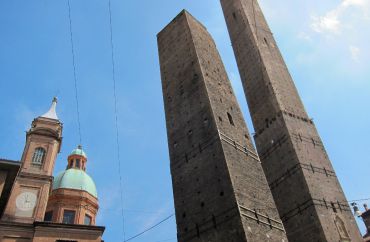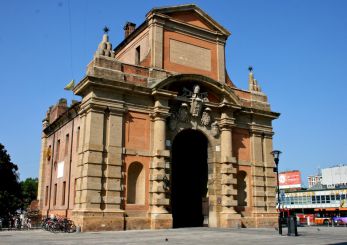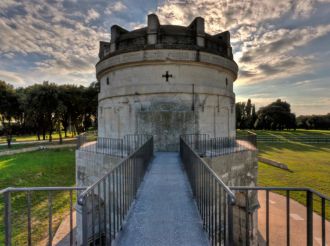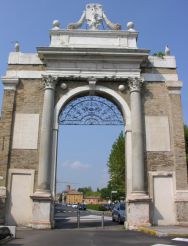Two Towers, Bologna

Two Towers – Asinelli and Garisenda – are a symbol of Bologna for both tourists and citizens. These leaning giants were built in the very heart of the city, at the crossing of 5 streets that lead to the 5 old city gates. And if the Leaning Tower of Pisa is the most famous among tourists, and everyone wants to hold it, then the Asinelli Tower in Bologna is the highest leaning tower in the whole world.
History of the towers
Construction of huge medieval skyscrapers, that is the towers, was a very popular thing among the nobility back then. This was a way to show their status, power and wealth. Moreover, many of the towers were meant to be defensive, it was convenient to observe the enemy from their top. According to various sources, there used to be from 100 to 180 towers in Bologna, only 24 survived till this day. The Asinelli and Garisenda tower that was built during the same period, from 1109 to 1119 is the most famous out of them all. However, the first record dates back only to 1185. There is no exact information about architects and people who commissioned the constructions. Presumably, the first one was erected for the noble knight Gherardo Asinelli and the second – for the rich Catholic family Garisenda. Both clans belonged to the Ghibelline faction. Initially, the towers were used as fortifications during the incessant medieval conflicts.
The Garisenda Tower was originally taller but in 1351 it was shortened and after the Drappieri merchant family purchased it. During the 19th century, the structure had three different owners. Finally, on August 27, 1904, it became the property of Bologna. Another tower nearby became of city ownership much earlier, in the 14th century after which it was used as a prison. At the time two fortifications were connected by a wooden bridge at a height of 30 meters which was destroyed by the fire in 1398. The Asinelli Tower, the tallest construction in the city back then was regularly struck by lightning until in 1824 a lightning rod was installed on it. Trade flourished here due to the convenient location and the towers were actively surrounded by retail shops, which negatively affected their state. In the late 19th century, they were all torn down. In the 20th century, a relay transmitter was set on the Azinelli tower, and in 1943–1945 it was used to adjust artillery fire. In 1998–2000 the towers were restored, its foundation and walls were strengthened. Then in 2015, a special lighting system was installed in towers.
Architectural design and features
The towers have a square base, their foundation goes deep into the ground by almost 10 meters. The foundation, which is underground, is supported by driven piles. The structure of the towers is double-layered: the inner wall is thicker, the outer one is thinner. The space between the walls is filled with stones and mortar. In addition, the closer to the top it gets, the thinner the walls become. This is done for a better stability. At the lower levels, there are several windows, the entire surface is covered with small grooves. The latter remained after the removal of scaffolds which were driven into the tower during the construction. In the Middle Ages, technologies for the construction of buildings of such a height were not sufficiently developed, and therefore over time, they began to lean.
The Garisenda tower used to have a height of 60 meters but after shortening due to the risk of falling, it became 48 meters high. Despite the smaller height, it has a bigger tilt angle than the neighboring Asinelli, the difference in the top and the lowest points equals 3.3 meters. Its neighbor which is 97 meters high has an angle of 1.3 degrees. It doesn’t seem to be a lot, but the difference in the top point is 2.2 meters. Today, the Garisenda Tower is closed for the public, the Asinelli, on the other hand, welcomes everyone. Guests can access the spiral staircase of 1658 which has 498 steps. At the top, the visitors can enjoy an unbelievably beautiful panoramic view of the city since this tower is the highest one in the old part of the city. This fascinating view even impressed the German poet Johann Goethe who did not forget to mention it in his notes.
Fun facts
The construction of the Asinelli tower has its own legend, quite typical for the Middle Ages. According to it, a shepherd who was in love and had several donkeys proposed to a rich girl. The father jokingly answered the guy that he would let this happen only if he built the highest tower in the city. Soon the young man found a treasure, hired builders, erected a tower and named it after himself – he was nicknamed as Asinelli. Naturally, the story had a happy ending: the wedding did take place.
Most likely, this is was just a tale. However, a lot of other facts are true. Asinelli survived a lot of fires, the most powerful were these two: arson in 1185 and accidental fire in 1398. In 1513, during some festivities, an eight-pound cannonball landed into the Asinelli tower, but it remained unscathed and stood firmly in its place. Scientists Giovanni Battista Riccioli (1640) and Giovanni Battista Guglielmini (1790) conducted experiments on its top to prove the fact of the Earth rotates. The Garisenda Tower was mentioned in the "Divine Comedy" by Dante Alighieri.
How to get
The towers are located in the heart of Bologna, in the middle of Piazza di Porta Ravegnana. Piazza Maggiore with its beautiful palaces is situated 5 minutes away from here. Several museums can be found nearby as well: the archaeological, Jewish and International Museum and Library of Music. The closest bus stops are Due Torri (buses № 14, 19, 25, 27, T1, T2) and Rizzoli (buses № 11, 13, 14, 30).
Opening hours: from March to November 5 from 09:30 to 19:30, from November 6 to February from 09:30 to 17:45. The ticket office closes one hour earlier. Contact number for inquiries: (+39) 051 6583111.
Admission: the price of a full ticket is 5 euros, the reduced one costs 3 euros and can be purchased by visitors over 65 and under 12, and groups of more than 20 people. The information about admission and opening hours may be changed.






